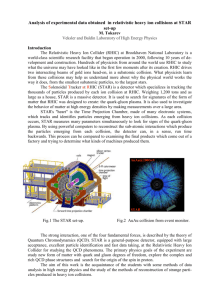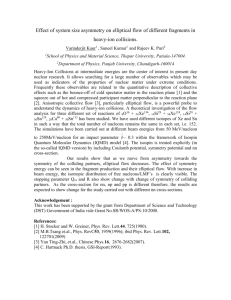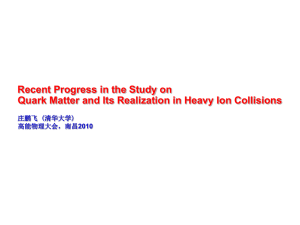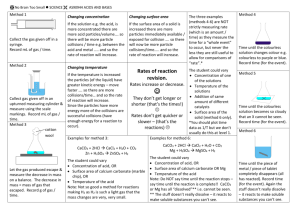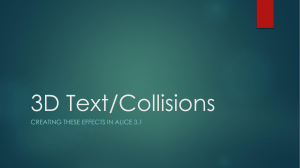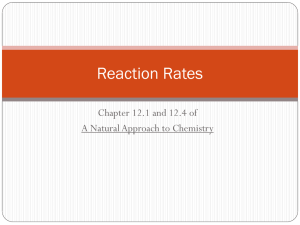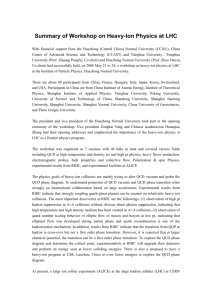phys224c - Nuclear Physics Group
advertisement
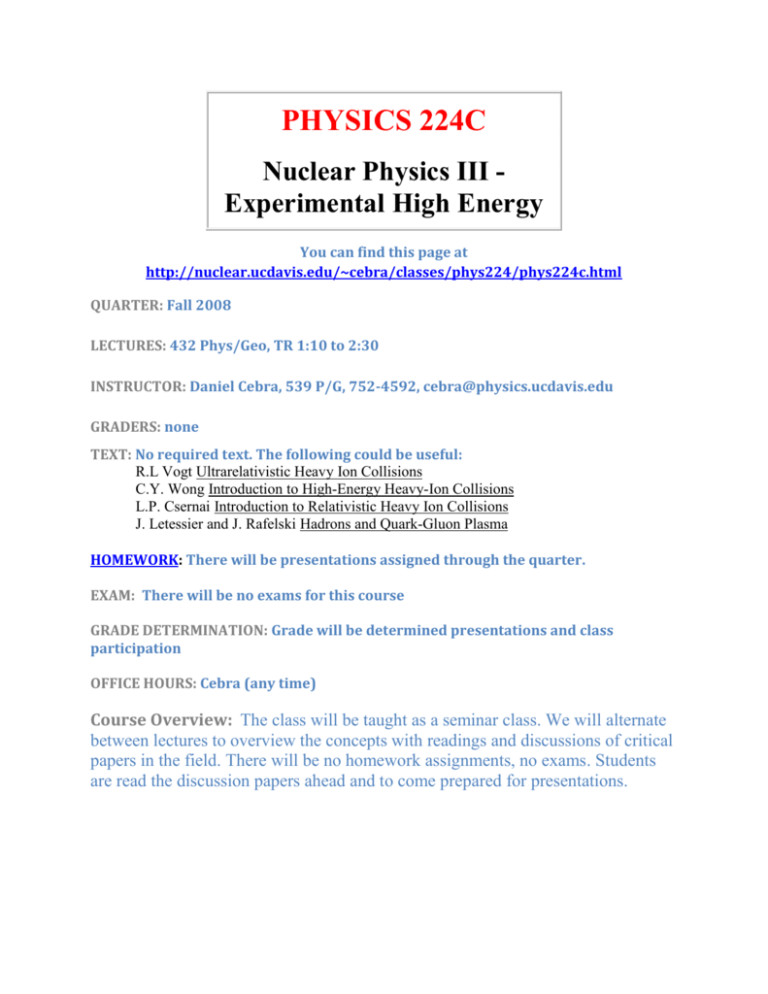
PHYSICS 224C Nuclear Physics III Experimental High Energy You can find this page at http://nuclear.ucdavis.edu/~cebra/classes/phys224/phys224c.html QUARTER: Fall 2008 LECTURES: 432 Phys/Geo, TR 1:10 to 2:30 INSTRUCTOR: Daniel Cebra, 539 P/G, 752-4592, cebra@physics.ucdavis.edu GRADERS: none TEXT: No required text. The following could be useful: R.L Vogt Ultrarelativistic Heavy Ion Collisions C.Y. Wong Introduction to High-Energy Heavy-Ion Collisions L.P. Csernai Introduction to Relativistic Heavy Ion Collisions J. Letessier and J. Rafelski Hadrons and Quark-Gluon Plasma HOMEWORK: There will be presentations assigned through the quarter. EXAM: There will be no exams for this course GRADE DETERMINATION: Grade will be determined presentations and class participation OFFICE HOURS: Cebra (any time) Course Overview: The class will be taught as a seminar class. We will alternate between lectures to overview the concepts with readings and discussions of critical papers in the field. There will be no homework assignments, no exams. Students are read the discussion papers ahead and to come prepared for presentations. Class Outline: The Class will follow the evolution of a relativistic heavy ion collision: I. Overview and Historical Perspective a. Hagedorn Bootstrap Model b. Bjorken energy density c. Basic Kinematics II. Quantum Chromodynamics a. Asymptotic freedom b. Confinement c. Chirality III. Initial Conditions and First Collisions a. Glauber Model --- pre-collision and initial geometry (impact parameter) b. Color-Glass Condensate c. Parton Cascade --- IV. Quark-Gluon Plasma Formation and Evolution a. Lattice QCD b. Hydrodynamics c. Elliptic flow V. Probes of the Dense Partonic Phase a. J/ Suppression and open charm b. Jets c. Direct Photons d. Di-Leptons VI. Hadronization a. Recombination vs. Fragmentation b. Chemical Equilibrium, Chemical freeze-out c. Strangeness enhancement VII. Thermal Freeze-out a. Pion production/Entropy b. Radial Flow c. HBT VIII. Accelerators and Detector for Heavy-Ion Physics IX. Implications a. Big Bang Cosmology b. BBN c. Supernovae d. Neutron, Strange, and Quark Stars Readings/References TOPIC I: General Overview and Introduction to Relativistic Heavy Ion Physics Chapter 1 of F. Halzen and A. Martin Quarks and Leptons Chapter 6 of Perkins and/or any other introduction to QCD Chapter 2 of Wong kinematic variables Statistical Thermodynamics of Strong Interactions at high Energies R. Hagedorn, Suppl. Nuovo Cimento 3, 147, 1965 Very High Energy Collisions of Hadrons R.P. Feynman, Phys. Rev. Lett. 23, 1415 (1969) Highly Relativistic Nucleus-Nucleus Collisions: The Central Rapidity Region J. D. Bjorken, Phys. Rev. D27, 140 (1983) Lectures given by R. Bellwied at Graduate Summer School, Germany 2004 1,2,3 Lectures given by John Harris at Winter Institute, Lake Louise, 2006 1, 2 The STAR Whitepaper nucl-ex/0501009 The PHENIX Whitepaper nucl-ex/0410003 CORE - COmpendium on RElations hep-ph/9507456 The Physics of Thermal QCD Smilga, hep-ph/9612347 TOPIC II: Quantum Chromodynamics Reading assignment for this lesson Lecture on foundation in QCD Smilga, hep-ph/9901412 Asymptotic Freedom and QCD Nobel Prize Lecture, Frank Wilczek, hep-ph/0502113 Gribov's lectures on confinement Lecture 1, hep-ph/9403218 Lecture 2, hep-ph/9404332 Why is a nucleon bound ? Ed Shuryak, hep-ph/9603354 Chiral Symmetry Restoration Volker Koch, nucl-th/9706075 TOPIC III: Initial Conditions and First Collisions Reading assignment for this lesson Glauber Model in RHI collisions nucl-ex/0701025 The Color Glass Condensate: an Introduction E. Iancu et al.,hep-ph/0202270 Comment: The important concepts are in the first part of the article, but a more ambitious reader should go on farther. TOPIC IV: Quark-Gluon Plasma Formation and Evolution Reading assignment for this lesson Phase Transitions in QCD H.Meyer-Ortmanns, hep-lat/9608098 Introduction to Lattice QCD Rajan Gupta, hep-lat/9807028 Comment: Read only sections 1-10. A long but introductory article. Read what you can for a first impression; but you will not be able to understand everything. Take down questions for class. Recent lattice Results Relevant for Heavy Ion Collisions Kazauyuki Kanaya, hep-ph/0209116 Comment: Short and should be of interest to students who work on RHIC physics. This will be discussed in more detail in class, so read and try to understand and mark down questions. Hydrodynamical models (I) nucl-th/0404039 Hydrodynamical models (II) nucl-th/0410017 Hydrodynamical models (III) Recent summary by Ruuskanen and Eskola, nucl-th/0605008 TOPIC V: Probes of the Dense Partonic Phase Reading assignment for this lesson Space-time Structure of Initial Parton Production in Ultrarelativistic Heavy Ion Collisions, K.J. Eskola and X.N. Wang, Phys. Rev. D, preprint LBL-34156 Jets in Relativistic Heavy Ion Collisions X.N. Wang and M. Gyulassy, preprint LBL-29390 GLV approach to radiative energy loss Gyulassy et al., hep-ph/9907461 BDMPS approach to radiative energy loss Baier et al., hep-ph/9607355 LPM effect in QED Baier et al., hep-ph/9604327 Energy Loss in High Energy Heavy Ion Collisions from the Hydro + Jet T. Hirano and Y. Nara, hep-ph/0208029 Summary of Status of RHIC data (II), P. Jacobs and X.N. Wang High pt probes, P. Jacobs High pT Azimuthal Asymmetry in Non-central A+A at RHIC STAR collaboration, PRL 90 (2003) High pt Tomography of d+Au and Au+Au at SPS, RHIC and LHC X.N.Wang, I. Vitev, M.Gyulassy, PRL 86 (2001) Gluon Shadowing and Jet Quenching in A+A Collisions at sqrt(s)=200A GeV X.N.Wang, M.Gyulassy, PRL 68 (1992) Heavy Quarks and QCD Matter D. Kharzeev, Nucl.Phys.A702 (2002) Charmonium Suppression Matsui and Satz,Phys. Lett. B 178 (1986) 416. Charmonium Suppression (experimental), NA50 Collaboration, Phys. Lett. B 450 (1999) 456. Heavy Flavor Energy Loss M. Djordjevic, hep-ph/0410372 TOPIC VI: Hadronization Reading assignment for this lesson Hadron Production in Au-Au Collisions at RHIC P. Braun-Munzinger, D. Magestro, K. Redlich, and J. Stachel, hep-ph/0105229 Thermal Phenomenology of Hadrons from 200 A GeV S + S Collisions E. Schnedermann, J. Sollfrank, and U. Heinz, Nucl-th/9307020 Chemical Equilibration in Pb + Pb Collisions at the SPS P. Braun-Munzinger, I. Heppe, and J. Stachel, nucl-th/9903010v2 Chemical Equilibration and the Hadron-QGP Phase Transition P. Braun-Munzinger, nucl-ex/0007021 Strangeness Production in the Quark-Gluon Plasma Rafelski et al., Phys. Rev. Letter 48, (1982) 12066 Rafelski et al., Phys. Rev. Letter 56, 2334. Strangeness Production in Heavy Ion Collisions Redlich et al., Nuc. Phys. A698 (2002) 94c. Resonance Production in medium C. Markert, nucl-ex/0503013 Topic VII: Thermal Freeze-out Reading assignment for this lesson Year-1 data from RHIC J. Nagle and T. Ullrich, nucl-ex/0203007 Early Bulk Data Summary T. Ullrich, nucl-ex/0211004 Summary of Status of RHIC data (I) B. Mueller and J.Nagle, nucl-th/0602029 Femtoscopy M. Lisa et al., nucl-ex/0505014 TOPIC VIII: Implications Reading assignment for this lesson Other Relevant Papers Supersymmetric string models in RHIC physics Policastro, Son and Starinets,hep-th/0104066 Supersymmetric string models in RHIC physics (II) Kovtun, Son and Starinets,hep-th/0405231 CGC+hydro+strings T.Hirano and Y.Nara,nucl-th/0404039/ From pions to pentaquarks Dmitri Diakonov, hep-ph/0406043
